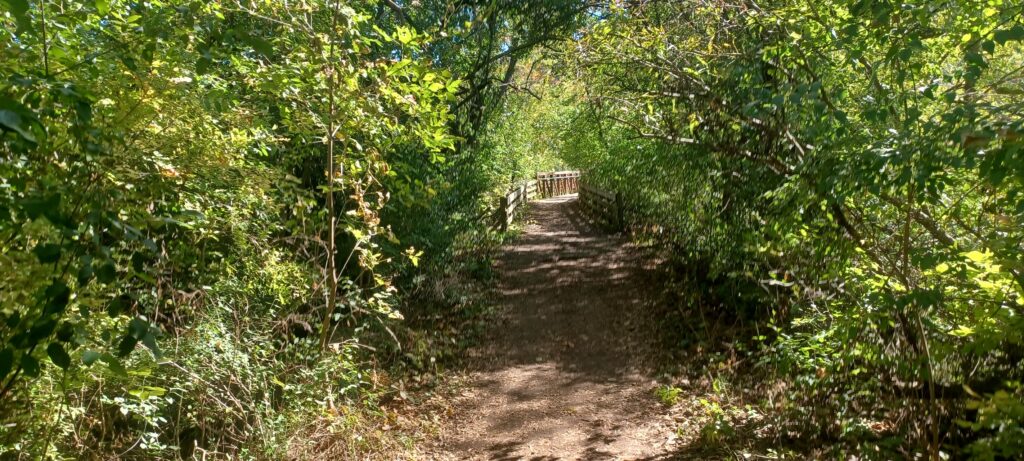In a Nutshell:
- Michigan’s natural resources and green spaces are valuable assets, providing recreational opportunities, flood control, wildlife habitat, and aesthetic value.
- Invasive trees and shrubs have severely reduced the value of many natural areas and green spaces. These invasives will propagate and spread to new areas without a strategic plan for control.
- Michigan should adopt and fund a coherent approach to sustainably manage invasive species, with additional emphasis on invasive shrubs and trees.
By Eric Paul Dennis, PE – epdennis@crcmich.org
Northern Michigan’s forests are special. The majestic trees and meandering streams provide a serene landscape that attracts tourists and provides recreational opportunities and improved quality of life for residents.
Plenty of forested areas and green spaces are found in southern Michigan, but they often do not hold the same allure. Forests in southern Michigan, particularly in and around urbanized areas, frequently appear cluttered, messy, and uninviting. An understory of shrubs and small trees often grows so dense that it is impossible to even see through the forest, never mind walking through it. If you’ve seen forests like this, most likely you have observed land that has been inundated with invasive trees and shrubs.
Image: This path through a natural area near Ann Arbor is shrouded by invasive Shrub Honeysuckle

Late autumn through early winter is a great time to spot invasive trees and shrubs. A few of Michigan’s most widespread woody invasives hold their green leaves longer than most any native species. These include Autumn Olive, Common Buckthorn, Shrub Honeysuckle, Barberry, and Siberian Elm. These invasives also tend to leaf-out earlier in the spring than many natives. This extended leafy-period is one of the features that allows these invasives to outcompete native species and amplifies their disruption to the ecosystem.
Image: Invasive shrubs displaying still-green leaves in late November
Invasive trees and shrubs tend to overwhelm native species and create monocultures, leading to reduced biodiversity. They also shade out grasses and herbaceous plants that protect soil, leading to soil erosion and watershed pollution. Additionally, the thick woody growth may amplify risk of wildfires during drought conditions. These ecosystem impacts are rarely noticed by most people, however, most Michiganders have probably noticed that these invasives form dense, impenetrable thickets that make a green space unsuitable for any recreational use. They also impact aesthetic value; in short, they’re ugly.
The failure to manage invasive trees and shrubs has transformed many of Michigan’s green spaces into “green blight.” These invasive-dominated green blight areas are common in Michigan’s urban regions. Without a coherent plan and adequately-funded response, woody invasive species will continue to spread across the state, further impacting the aesthetic, recreational, and economic value of Michigan’s natural resources.
“Green Blight” – Undeveloped and unmanaged vegetated areas that, due to proliferation of invasive species, provide very little recreational, ecosystem, or aesthetic value.
Michiganders place a high value on undeveloped “natural areas.” However, due to factors such as fire control, loss of wetlands, and, especially, invasive species, it is no longer possible for many of Michigan’s green spaces to approximate truly “natural areas” without human intervention. Nature needs our help. Green spaces require maintenance.
The photo below was taken at a nature preserve in Washtenaw County. Previously a farm field, this land was donated to a conservancy in 2007 and seeded with native grasses and wildflowers. The plaque is titled, “Old Fields: Habitats on the Mend,” and goes on to describe a natural progression of prairie to forest, where “increasing numbers of plants will begin to create rich topsoil, allowing oaks, elms, dogwoods and ashes to thrive.” Unfortunately, the natural progression described in the plaque is no longer possible in this area. The donation did not include provisions for invasive species management and the site is now a thicket of invasive woody shrubs that provide very little ecosystem or recreational benefit. Native species are nearly absent. The nature preserve has become green blight.
Image: Land donated to a land conservancy in 2007 has become a thicket of invasive Buckthorn

There are examples of such green blight across Michigan’s roadsides, natural areas, preserves, parks, and dedicated green spaces. Valuable land has been set aside for the benefit of the public but provides none. This is largely due to lack of vegetation management, especially pertaining to woody invasive species.
In September of 2023, the Citizens Research Council released a report, “Michigan’s Path to a Prosperous Future: Environmental Challenges and Opportunities.” The report highlighted that “Michigan’s environment and natural amenities could be a core asset to attract new residents and investments.” The report also noted that prior waves of invasive species have already caused substantial ecological and economic damage to the state. Given this history, it is alarming how little attention is dedicated to preventing future harm.
An example of a successful invasive species management program is the invasive sea lamprey control program. Sea lampreys became established in the Great Lakes basin in the 1920s. These eel-like fish are parasitic on larger fish species and caused incredible damage to native fish populations and commercial fisheries by the 1950s. To protect natural resources and fish stock, a new organization was created through a binational treaty of the U.S. and Canada: The Great Lakes Fishery Commission (GLFC). Through strategic and targeted management efforts, the GLFC has reduced the lamprey population by 90 percent from its 1950s peak. The ongoing effort costs about $30 million annually (with funding provided at the federal level through both the U.S. and Canada), but protects natural resources and a regional fishery worth an estimated $6 billion.
Similar to the sea lamprey, it is not possible to completely eradicate woody invasive species, but they can be managed. Management requires ongoing funding. Currently, Michigan’s Invasive Species Program receives only $5 million per year. This funding must cover research and management of all invasive species. Most of the efforts are targeted at aquatic invasives, exotic insects, and blights that threaten native tree species.
Woody invasives are given very little attention in state policy. This is partly because it was believed until recently that invasive plants, shrubs, and trees did not pose much of a threat to established forests. However, recent observations and new research show that many shade-tolerant invasive trees and shrubs can infiltrate established forests and drastically degrade the ecosystem.
State agencies, including the Department of Environment, Great Lakes, and Energy (EGLE), the Department of Natural Resources (DNR), and the Department of Agriculture and Rural Development (MDARD) are beginning to recognize the threats posed by invasive vegetation. Non-profit organizations such as the Woody Invasives of the Great Lakes Collaborative (WIGL) and the Midwest Invasive Species Information Network (MISIN) have also stepped-up efforts to increase awareness and conduct limited mitigation projects. However, without dependable funding backed by state policy, these efforts are fragmented and mostly volunteer-based. This approach is no substitute for a coherent statewide strategy and management plan.
In order to leverage Michigan’s forests and natural resources as a driver of population growth and economic development, Michigan must dedicate more resources to understanding the impacts and threats from woody invasive species. Given appropriate funding, Michigan should initiate an effort to understand the extent and severity of woody invasive species establishment across the state, as well as impacts and threats to Michigan’s economy and natural resources. Once the problem is better understood, we can evaluate the costs and benefits of a woody invasive species management plan.
Without such an effort, Michigan’s forests and the state’s future remain at risk.
Related Posts from CRC:

